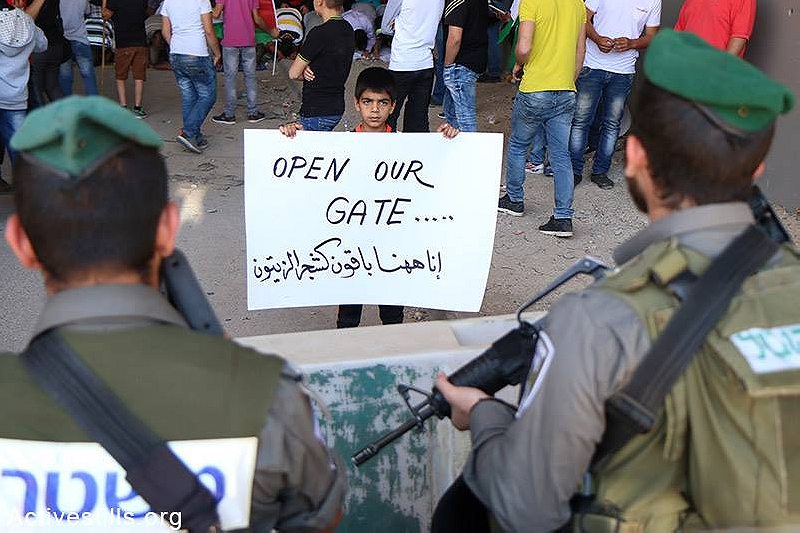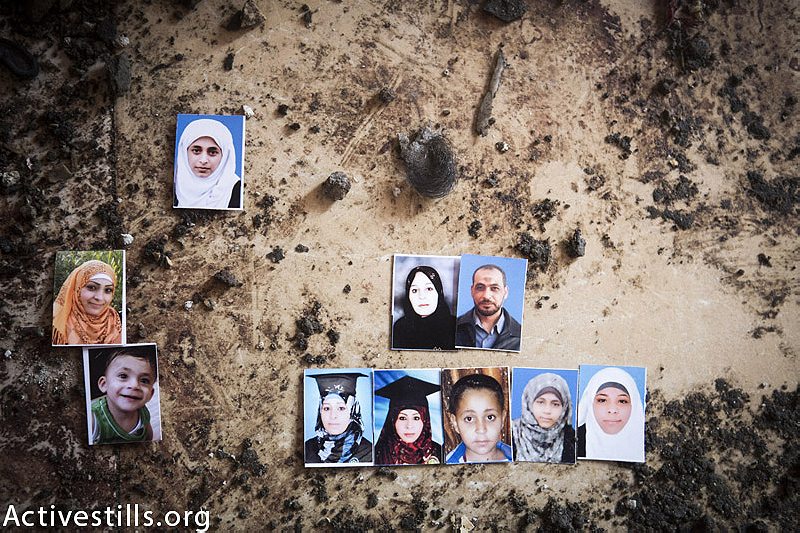A group of photographers from Israel, the Palestinian Territories, and elsewhere provides an unusual example of cooperation across the Green Line
It was a blisteringly hot July afternoon near Ramallah, and Ahmad Al-Bazz had been sweating in the sun for seven hours, waiting to go to jail. Israeli soldiers inspecting his car at a checkpoint saw cameras and a gas mask. Al-Bazz was a photojournalist on his way to cover protests, but that didn’t matter to the soldiers.
“You will stay here,” Al-Bazz remembers a soldier telling him, “and a military car will come later to take you to prison.”
After two hours they brought him water, but the day ticked by and after seven hours, there was no car and no prison. And then the soldiers let him go. Al-Bazz is still not sure why.
It was hardly a rare occurrence: In Palestine, movement is always difficult. The separation wall cuts roads in two and unpredictable ‘flying’ checkpoints appear in the road, doubling or tripling the length of commutes.
Al-Bazz, 23, is a member of ActiveStills, a collective of young, self-described activist photographers that cover breaking news and document social and political issues across Israel and the Occupied Palestinian Territories. An unusual example of cooperation across the Green Line, the group has 10 members from Israel, Palestine, the United States, and France stationed across the country. ActiveStills sells photos on a freelance basis to newspapers and donates them free of charge to NGOs, some activist organizations, and anyone they photograph.
Oren Ziv, a 30-year-old Israeli from Haifa, was one of four photographers who founded ActiveStills in 2005. Working in the West Bank and living in Tel Aviv at the end of the Second Intifada, Ziv found it hard to reconcile the two realities he encountered: dodging rubber bullets and smelling tear gas, and then coming home to a normal life, watching people relax on an ordinary Friday afternoon.
The group recruited Palestinian photographers, because they wanted people who not only understood the stories, but also lived them. Al-Bazz joined the group in 2012 as its first Palestinian member. Like many Palestinians, he’s forbidden from traveling in Israel, Jerusalem, and Gaza without a permit. When he was younger he spent the better part of a decade virtually trapped in his hometown of Nablus, a city in the northern West Bank. Soldiers and dirt piles blocked the roads, and on most days the only route in and out of town was a circuitous trek through the mountains. “We couldn’t take our cars outside of Nablus, so you took a donkey. You put your luggage and you took another car. It was crazy,” he said in Ramallah recently.

In March, Al-Bazz spent three days photographing the military blockade of Qabatiya, a small West Bank town shut down by the Israel Defence Force after three young men from the area killed a 19-year-old border police officerin Jerusalem. For three days soldiers raided homes, made arrests, and fought with protesters.
It was a familiar scene to Al-Bazz. “You feel so connected and so close to these people,” he said. “This is your community, your place, your people.”
ActiveStills aims to cover ideas more than events. So when they wanted to photograph the displacement of Palestinians, they had a handful of photographers and years of archives to draw on, covering the demolition of unrecognized Bedouin villages in Israel’s Negev Desert, evictions of Palestinians in East Jerusalem, and refugees of the Gaza wars.“By having people from everywhere, we can cover the whole country,” Al-Bazz said.
A media studies major and student activist at An-Najah University in Nablus, Al-Bazz met Anne Paq, a French photographer and ActiveStills member, while covering a protest. He knew her work and he liked the idea of joining the collective and doing more journalism. But he wasn’t sure about working with Israelis.
For many on Al-Bazz’s side of the wall, the only experience they have with Israelis are encounters with soldiers or settlers at spots like the Qalandia checkpoint into Ramallah, where Palestinians traveling into Israel line up to present their ID in a wire cage under the eye of a soot-covered guard tower blackened by firebombs.
“Here, it’s not too popular between people to cooperate with Israeli people,” Al-Bazz said.
Even Ziv, who is a familiar face in the West Bank after more than a decade working there, is cautious when he travels to unfamiliar communities. “It’s not easy to explain to each one you meet in the street your story and what you’re doing,” he said.
But working with ActiveStills was different, Al-Bazz said, because he and the group members all believed in the same thing. ActiveStills’ politics aren’t a secret: Their website calls for an end to the occupation of the West Bank and the Golan Heights, and for the removal of the separation wall.
“Some people do medical care, some people do legal aid. We do photography, and we see ourselves as part of something—of a movement,” Ziv said.

As a teenager, Ziv deferred his military service and spent a year doing volunteer work in Jaffa, a historically Arab town just south of Tel Aviv. He later successfully challenged conscription into the IDF by convincing a review board of military officers that he was a pacifist, something few manage to do.
Ziv talks passionately about his early experiences photographing in the West Bank, covering protests against the occupation. One of his first long-term projects was photographing weekly demonstrations in Bil’in against the separation wall, which ran through the village and separated people from their land.
“The smell of tear gas and being there, it’s different than reading about it and seeing it in photos,” he said.
Still, he and Al-Bazz say that when they’re in the field, they work like journalists. “We are activists in our agenda, our issues that we cover, our type of work,” Al-Bazz said. But “the final output is neutral.”
ActiveStills often goes places where few other journalists risk venturing, such as community demolitions in military firing zones or covering clashes with the IDF in forgotten West Bank towns. That can put them at greater risk than most.
ZIV HAS BEEN SHOT WITH RUBBER-COATED STEEL BULLETS, GASSED, AND ARRESTED OR DETAINED A HANDFUL OF TIMES
Sitting on a restaurant terrace in downtown Jerusalem, Ziv describes being shot in the head with a sponge bullet in about the same tone of voice he uses to order his hummus. In the summer of 2014, after Israeli settlers kidnapped and burned to death a 16-year-old Palestinian boy from East Jerusalem, Ziv covered a protest in Shuafat, the boy’s home neighborhood. Riot police shot at a group of journalists with sponge bullets, and Ziv was hit in the back of the head. ActiveStills member Tali Mayer was shot in the face. Both were hospitalized.
It wasn’t the first time: Ziv has been shot with rubber-coated steel bullets, gassed, and arrested or detained a handful of times. “All of us were at some point injured, or arrested, or both, more likely,” he said.
Al-Bazz remembered taking pictures of a Palestinian photojournalist who was shot in the face with a rubber-coated steel bullet near Nablus while covering a protest on Israeli Independence Day. He was shooting video at a protest in the Palestinian village of Beit Farouk last fall when Israeli soldiers attacked two AFP photographers and destroyed their gear. His footage convinced the IDF to suspend the soldiers’ commander and is being used as evidence in a civil suit against the military.
“You feel like one day it could be you, to be a story for other journalists,” he said. “Every time I go—I’m a Muslim, I’m a religious person—so I ask my God, ‘Please, I want to go back safely.’”
He said his emotions have hardened since last fall, the beginning of what some in the country call the “Knife Intifada,” when deadly violence once again became routine. “Since last October, I saw dozens of dead people in front of my eyes. So now, if you bring a body here, it will be okay,” he said. “It’s not because I’m not an emotional person—I am—but by time, you get used to it… In Arabic, we say you become a rock.”

For Anne Paq, a 39-year-old French photographer who worked during the 2014 Gaza war, getting home safely eventually meant leaving before she pushed her luck too far. “I reached a breaking point. It’s time to go because you might make some mistakes,” she said.
The wall was just going up when Paq arrived in the West Bank in 2003. “You feel shocked, and then you feel like you want to react. I wanted to do something, to react to this injustice and to raise awareness, and I found that photography was the best tool I had to do that.”
She lived in the West Bank until 2014 and often traveled to Gaza. She was there in 2012 when the IDF began an eight-day offensive and she returned two years later when the conflict escalated again. About 1,500 Palestinian civilians died in two months of fighting.
“In 2014, it was another level of war,” Paq said. Since 2014, she has been working on a project called Obliterated Families, which documents some of the at least 142 families who lost three or more members.
It hasn’t been easy to talk with those families again, some of whom she met in the streets of Gaza, outside the morgue as their dead parents, siblings, cousins were brought in.
“I don’t have this barrier I put between me and them. I am emotionally there. It becomes personal, not professional,” she said. “You can see the people breaking down in front of you, and you’re wondering ‘Is it the right thing to do?’ I’m coming here and they have to open their wounds again.” Paq added, “For me, the point is there is a story to tell and it’s important to tell it.”
Top image: A Palestinian youth places a flag on the Israeli Separation Wall during a protest marking nine years for the struggle against the wall in the West Bank village of Bil’in, February 28, 2014. Photo by: Oren Ziv/Activestills.org